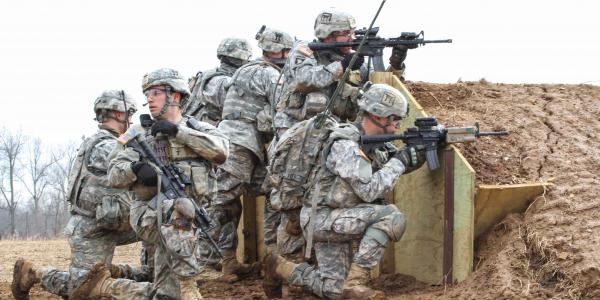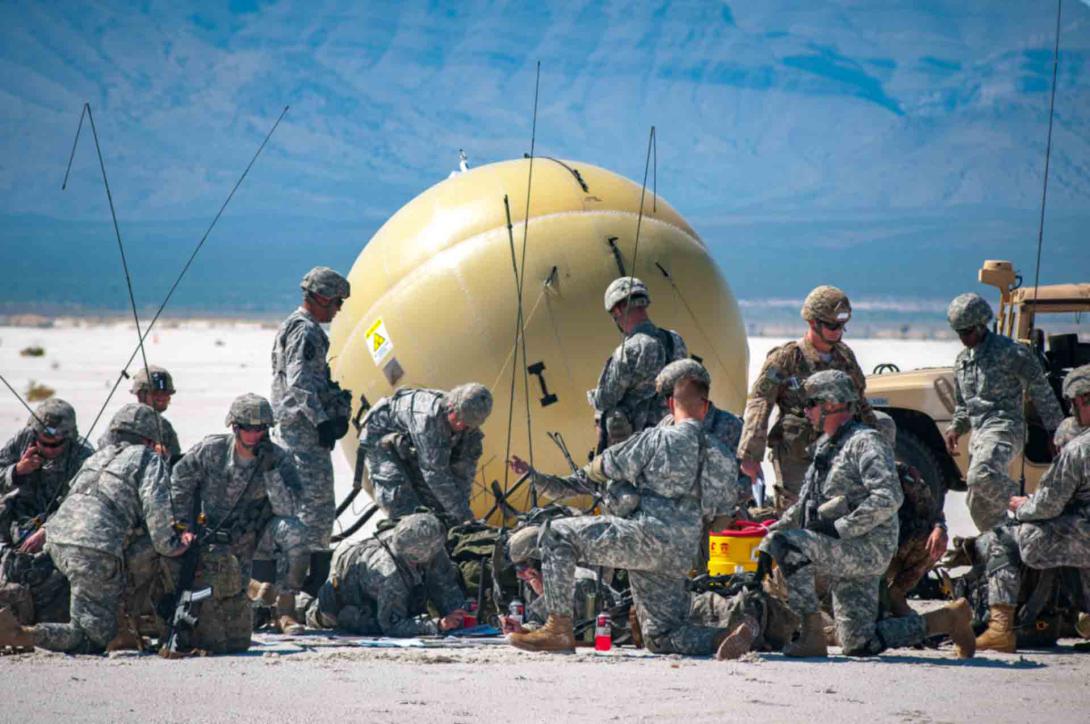Extending Tactical Communications
As U.S. Army leaders assess the future of tactical communications and networking programs, the service is moving forward with several measures to extend improved capabilities to soldiers at the platoon and squad levels.
Service officials spent most of the summer participating in a major review of the Army’s network modernization strategy. Gen. Mark Milley, USA, the Army chief of staff, informed Congress in May that he had directed a “rigorous and painful review” of tactical communication programs out of concerns that systems being developed may not be sufficiently hardened against electronic attacks.
During the years of combat in Iraq and Afghanistan, the service did not have to worry so much about electronic signal detection or interference. That likely will not be the case in the future. “Even smaller countries can now find those kinds of capabilities available on the dark web or other places. We can’t assume we have complete superiority in the electromagnetic spectrum,” says Maj. Gen. Jennifer Napper, USA (Ret.), vice president, Defense and Intelligence Group, Unisys Federal Systems.
Along those lines, Col. Jim Ross, USA, the Army’s project manager for tactical radios, says the service is working to strengthen waveforms. For example, his team intends to update the widely used Single Channel Ground and Airborne Radio System (SINCGARS) waveform.
Gen. Napper suggests that upgrading SINCGARS will provide major benefits. “If you think about how many SINCGARS we have in the inventory, you don’t want a wholesale replacement, but being able to upgrade the software would be huge because then you could change anytime you really needed to based upon the adversary,” she states. “That would make it very hard for the adversary to contest us in that environment.”
The service also endeavors to provide warfighters with new and improved tactical radios. For example, officials expect to make a full-rate production decision sometime in fiscal year 2019 on a new Manpack Radio being developed under the Handheld, Manpack and Small Form-fit program. The full-rate production radio is expected to weigh 2 pounds less, generate less heat and use longer-lasting batteries than the current low-rate initial production version. The service has purchased more than 5,000 of those radios.
The Manpack is a two-channel radio that can be carried in a backpack or mounted in a vehicle. It also can operate on multiple waveforms, including the Soldier Radio Waveform used by the Rifleman Radio and the SINCGARS waveform, both of which are terrestrial, line-of-sight waveforms. Normally, this type of waveform only communicates with radios that are relatively close.
But the Manpack radio also can operate on the Navy’s Mobile User Objective System (MUOS) waveform, which communicates well beyond the line of sight. The MUOS is the Navy’s next-generation satellite communications system providing voice and data communications for U.S. forces anytime, anywhere. The integrated ground segments for MUOS will deliver cellphone-type communications for warfighters on the move. Although MUOS is a Navy waveform, the Army’s Manpack radio is the first, and so far only, system certified to use it.
The Manpack, using the MUOS, can act as a message-routing or retransmission station, which is where things get interesting for individual soldiers operating the handheld Rifleman Radio, Col. Ross indicates. “You could have a soldier on a Rifleman within a squad … talk to any other soldier and to any other element outside of their immediate line-of-sight radio anywhere in the world,” he explains. “Messages come in on the Soldier Radio Waveform and on these other channels, go out over MUOS, through the constellation of satellites and down to another Manpack. And then it routes and retransmits back over the Soldier Radio Waveform to another Rifleman Radio.”
The AN/PRC-154 Rifleman Radio is a software-defined, reprogrammable, networkable, single-channel radio capable of simultaneous voice, data and video communications. It acts as its own router and is not dependent on fixed infrastructures, such as cellphone towers. Soldiers can communicate with anyone on the network and send information up and down the chain of command as well as into the network backbone provided by the Warfighter Information Network-Tactical.
Non-line-of-sight (NLOS) communications is a capability soldiers at the squad and platoon level do not yet have. “This will extend, of course, platoons over a wider battlespace, so that, for instance, we could have a forward observer out on a mission observing a target and be able to talk via his radio to his higher command and give targeting information directly to that fire direction center,” Col. Ross suggests.
And once an attack has been launched, the forward observer can instantly communicate the results to the fire direction center. “That’s something that’s never, ever been done,” the project manager says.
He adds that the capability has been demonstrated during an Army Network Integration Evaluation. “We’re utilizing already available capabilities, such as fire and support applications that are provided under the Project Manager Mission Command office. The [mission command] information is transmitted over the MUOS waveform utilizing our radio as a transmit mechanism back to the fire direction center,” he says.
The next-generation Manpack system will offer other improvements as well. It will be about 2 pounds lighter, and the batteries will last about two hours longer. That extra battery life may not sound like much, but to warfighters lugging batteries across the battlefield, it makes a difference. “By virtue of extending the battery to an eight-hour capability, for a 24-hour mission, soldiers need only three batteries. You need four with the current version,” Col. Ross offers.
The battery life ultimately could be extended even further. “We’re looking at all kinds of innovative technologies from industry and academia as well as our research and development centers. We need to improve that capability. That’s probably the toughest [challenge] to meet right now,” he says.
Today’s system also requires a high-powered amplifier, which generates a lot of heat and adds to the size and weight. For the next-generation system, that amplifier will be integrated into the radio’s internal electronics, and the radio can be carried in an improved, more breathable backpack developed by the Natick Soldier Systems Center to reduce overheating.
“We’re listening to the force. We know the problems in the past with our radios centered on heat and the batteries and, of course, the weight,” Col. Ross states. “We want to make it lighter, in terms of mission weight. We’ve heard from soldiers that we need less of a heat signature, with as much or more capability than we have today. That’s really what we’re going after.”
In some cases, soldiers are actually required to carry two single-channel radios: the Rifleman and the SINCGARS Advanced System Improvement Program (ASIP). But the Army aims to improve that situation too. The service is engaged in a program essentially to combine the two technologies. “Soldiers want a smaller system, but they also want both SINCGARS and the Soldier Radio Waveform. We’re taking the one-channel Manpack ASIP radio and the one-channel Rifleman, and we want to merge them into one, [with] not much more weight than the initial Rifleman Radio. Technology has advanced to the point where we can do that,” Col. Ross says.
The program schedule will follow roughly the same timeline as the next-generation Manpack program, with operational testing to be done sometime in fiscal 2019.
Overall, Gen. Napper voices approval for the Army’s tactical radio plans. “What we talked about 20 years ago, we’re actually seeing as reality. We’re seeing software-defined radios coming out and actually being put into use,” she says.
Gen. Napper also promotes the idea of a single handheld communications device, such as a smartphone capable of transmitting over multiple waveforms. Maj. Gen. Paul Funk II, USA, III Corps commander, floated the idea while speaking in August to the AFCEA TechNet audience in Augusta, Georgia.
“The vision is that you should be able to take something as small as a smartphone and do any waveform, do voice and data,” she offers. “As [Gen. Funk] said, it doesn’t have to be one waveform that solves all the issues. It actually can be the changeout chips, or changeout modules.”
That approach would be almost the opposite of the service’s usual path. “All you’re really doing is taking that smartphone and changing out the transmission pieces as opposed to what we’ve done historically, which is to take a radio and try to add the other capabilities on top,” Gen. Napper offers. “Go the other direction. That is where we’re going to see real capabilities on the battlefield.”
She adds that the technology for such a device could be available soon—three to five years maximum. “That’s going to be the next greatest thing,” Gen. Napper predicts.






Comments